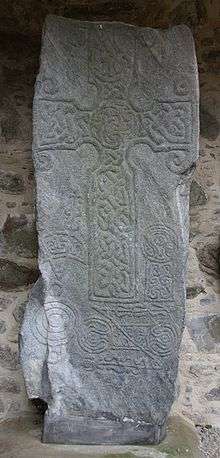Dyce stones
The Dyce stones are a collection of Pictish and Early Medieval sculptured stones that are housed in a shelter in the ruined St Fergus's Chapel, Dyce, Aberdeen, Scotland. There are two larger stones, known as Dyce I and Dyce II, that bear idiomatically Pictish symbols, as well as several smaller sculptured stones.
| Dyce stones | |
|---|---|
 Dyce II | |
| Symbols | Dyce I: Pictish Beast; Double disc and z-rod Dyce II: Knotwork interlaced cross; Crescent and v-rod; triple disc; double disc and z-rod; mirror case |
| Created | Sixth-Ninth Century CE |
| Place | Dyce, Aberdeen, Scotland |
| Coordinates | 57.2293°N 2.2082°W |
| Classification | Dyce I: Type I incised stone Dyce II: Type II cross slab |
| Culture | Picto-Scottish |
Dyce I
This is a Class I stone, bearing incised Pictish symbols. The symbols are the Pictish Beast and the Double disc and z-rod.
Dyce II
This is a Class II cross slab bearing a celtic cross decorated with knotwork and a central boss with spiral work. round the base of the cross are the Crescent and v-rod, Double disc and z-rod, triple disc and mirror case. On the side is an ogham inscription that transliterates as:
- EOTTASSARRHETODDEDDOTS MAQQ ROGODDADD[1]
Gallery
 Dyce I
Dyce I
gollark: (or change the free tier, I suppose)
gollark: Forever iff Oracle doesn't implode.
gollark: It's fine\* though; soon, *soon*, onstat will be cloud.
gollark: Nim bootstrapping continues to use 100% of the 1/4 of a CPU this instance gets.
gollark: Maybe I should have used one of the ARM instances.
References
- Fraser, Iain (2008), The Pictish Symbol Stones of Scotland, Edinburgh: RCAHMS
This article is issued from Wikipedia. The text is licensed under Creative Commons - Attribution - Sharealike. Additional terms may apply for the media files.